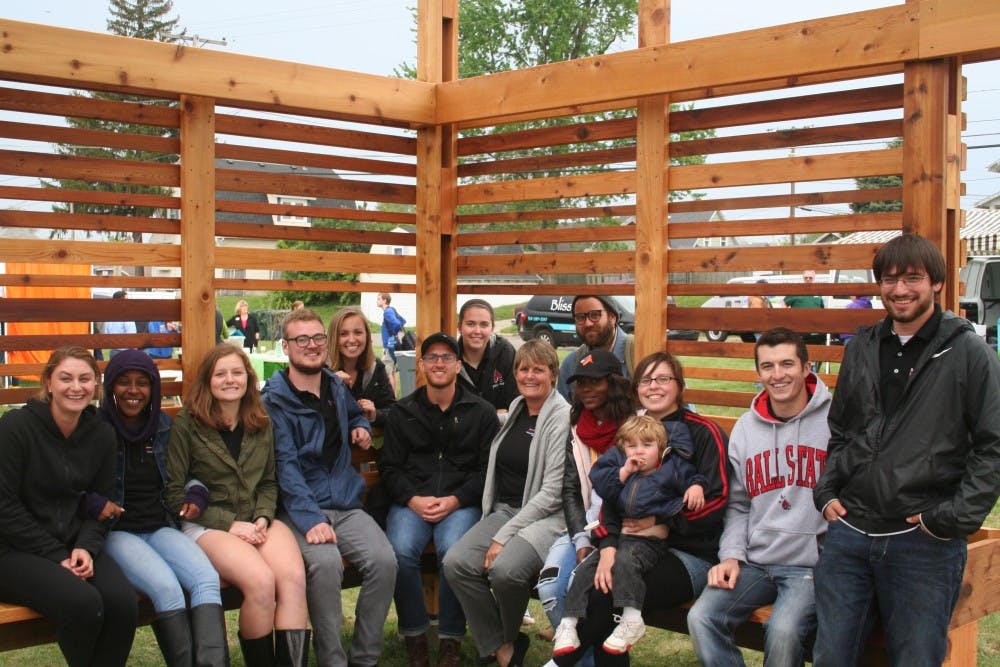What was once an empty patch of land near Maring-Hunt Library in Muncie is now an award-winning community space because of the efforts of a Ball State professor and her team.
Pamela Harwood, a professor of architecture, received an immersive learning award from the university Jan. 22 for her leadership of the Maring-Hunt Community Garden immersive learning project.
“The most rewarding part for me as an educator in this is the process of seeing the transformation in the student when they start to understand the process of truly engaging and impacting a community,” Harwood said. “It's like a light goes off in their head.”
The project, which involves 59 students in total, aims to alleviate food insecurity in the neighborhood surrounding the library by giving residents access to a community space where they can grow fresh fruits and vegetables.
Harwood said the 2017 Marsh grocery store closings had an impact on the food deserts of Muncie.
Food insecurity in the United States reached around 7.4 percent of American households in 2017, an increase from 7.3 percent last year, according to a report from the United States Department of Agriculture (USDA).
In order to create a space that was appropriate for the needs of the surrounding neighborhood, Harwood’s team worked with the 8twelve Coalition, a neighborhood organization dedicated to meeting the community needs of the nine blocks bordered by Eighth Street and Memorial Drive.
Harwood and her students worked on the project across three semesters, during which it grew from a simple pavillion, garden and set of benches into a more fully-realized community space that repurposed old features of the land — like turning a dilapidated running track into a small trail.
“When we started to dig, we actually found the old track [of Wilson Middle School], because of its gravel,” Harwood said. “That early on gave us a strategy to make the history of this [land] alive in the present by organizing these pavilions along this track and developing the entire track as a walking trail that would allow a series of pockets and pavilions and places of opportunity to encircle the entire garden.”
By the time the project was completed, the track was home to a number of pavilions, learning opportunities and scenic areas.
Architecture students Emma Mappes and Nick Entrekin worked on the project when it was in its early planning stages of the first semester. They said much of their success with the garden stemmed from good leadership and communication between the leaders, planners and community members.
“I think that even though we were on multiple teams, everyone bought into the vision, and that was important,” Mappes said. “It was kind of a struggle in the beginning to get everyone’s ideas on the same page with what the community needed and what they wanted, but once we figured that out and had a solid plan, then I think everyone bought into that idea.”
Often times, when the groups reached an impasse in their ideas, Harwood acted as what Entrekin described as a “peacekeeper.”
As leader of the project, Harwood was responsible for most of the funding work — which came through grants from the immersive learning system, the Ball Brothers Foundation and Lowe’s. However, Harwood got involved with the students as much as possible.
“[Harwood] was very involved in the design process,” Entrekin said. “It’s like sometimes she’s another student. She can come in and sit down and work with us and her ideas are just as good as ours.”
Harwood’s leadership was recognized alongside four other immersive learning projects — of which, two projects also targeted food insecurity in Delaware County.
With her efforts recognized alongside the other immersive learning projects and the garden completed, Harwood said she looks forward to celebrating and enjoying its many benefits with the community it supports.
Residents can use the space for $25 in order to finance the equipment, repairs and seeds.
Contact John Lynch with comments at jplynch@bsu.edu.





